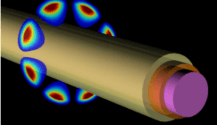Nanoplasmon ‘whispering gallery’ slashes emission lifetime in semiconductors
on

Taking a cue from ‘whispering galleries’ built into cathedrals by Renaissance architects, researchers at the University of Pennsylvania adapted the principle to nanoscale devices to drastically reduce emission lifetime, a key property of light-emitting semiconductors. A whispering gallery is a circular chamber designed to reflect and direct sound waves so that a whisper can be heard across the room.
When a semiconductor material is excited, it takes a few nanoseconds to return to the ground state, which is accompanied by emission of light. This delay is called the emission lifetime. For devices such as modulators, which must switch back and forth between two states, the emission lifetime sets a limit to the switching rate. The novel approach taken by the researchers reduces the emission lifetime to less than a picosecond – more than a thousand times faster than anything else currently available.
The unique structure of the nanowires constructed by the research team holds the key to the drastically reduced emission lifetime. They have a core of cadmium sulphide (a commonly used nanowire material), surrounded by a buffer layer of silicon dioxide and an outer layer of silver. The silver layer supports surface plasmons – unique waves consisting of a combination of oscillating metal electrons and light. These surface plasmons are highly confined to the junction between the silicon dioxide and the silver layer. Previous researchers had placed nanowires on a metal surface; the innovative leap consisted of wrapping the metal surface around the wire to form a nanoscale plasmonic cavity and achieve the whispering gallery effect.
With specific nanowire sizes, resonance pockets are formed in the silver layer, resulting in highly confined electromagnetic fields within the nanostructure. The emission lifetime can then be engineered by precisely controlling the electromagnetic fields inside the cadmium sulphide core, which is the light-emitting medium. To achieve an emission lifetime in the femtosecond range, the researchers had to find an optimal tradeoff between confinement and the Q factor of the cavity. Confinement and the Q factor are inversely related – confinement decreases as the Q factor increases. However, by opting for a moderate Q factor the researchers were able to vastly increase the confinement of the electric field inside the nanowire by resonant surface plasmons and achieve a record-breaking emission lifetime.
Image: University of Pennsylvania


Discussion (0 comments)